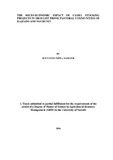| dc.description.abstract | Climate change is a reality and has impacted negatively on the Kenyan rangeland. Cyclic droughts continue to pose a threat to pastoralists whose livelihood is based on livestock. (Re) stocking of camels by various development agencies and partners was meant to address pastoralist’s household food security and resilience. This study assessed the social-economic impact of camel stocking projects with emphasis on non-traditional camel keeping communities. The objectives of the study were: (i) to analyze the seasonal contribution of camel milk to the household food basket, (ii) to determine the seasonal contribution of camels and camel products in the household economy and (iii) to determine the impact of drought on livestock species. This study was conducted in Kajiado and Ngurunit, though a pre-test of the data collection instruments was done in Merti sub-county. The target population comprised of beneficiaries of camel stocking projects and their controls (non-camel beneficiaries). The overall sample size consisted of 73 and 204 respondents in Kajiado and Ngurunit respectively. In Kajiado, 42 beneficiaries and 31 controls were interviewed. On the other hand, 180 beneficiaries and 24 controls were interviewed in Ngurunit. A household questionnaire was administered to all the respondents and a total of 16 Focus Group Discussions (FGDs) were conducted. A mix of stratified, simple random sampling and purposive sampling were employed in the study areas. Data was analyzed using Statistical Package for Social Sciences (SPSS). The study revealed that a majority (>73%) of camel beneficiaries consumed camel milk in the wet and dry seasons. On average, cow’s milk ranked first in livestock milk preference in both Ngurunit (75.5%) and Kajiado (80.8%). However, during the dry/drought period, camel milk ranked first in milk reliability in Ngurunit (59.8%), whereas goat milk ranked first in Kajiado (52%). Camel sales were not a major source of income in the short run. However, there was a
xvi
significant effect of historical camel sales in Kajiado in the long run. Camel milk featured as a regular source of income in Ngurunit in the wet (67%) and dry (54.4%) seasons respectively. Additionally, camel milk nowdays ranked first by (48% HHs) in income generation from livestock species milk in Ngurunit, compared to (1%) held before camel stocking. Kajiado was hard hit by drought compared to Ngurunit although the latter was more affected by camel diseases. Over 99% of the camel beneficiaries ranked camels first among other livestock species in its ability to withstand drought. In conclusion, despite the fact that camels played a crucial role in the household food security, the communities still showed a strong attachment to cattle. Camels and goats also showed greater ability to withstand drought than grazers with the changing climate. The recommendations from this study are: (i) upscaling of camel stocking initiatives (ii) capacity building of camel keepers (iii) increasing centres for (camel) breeding stock and (iv) drought preparedness & mitigation measures. The findings can be used by livestock stakeholders and policy makers in developing sustainable strategies to enhance pastoralist’s food security and drought resilience. | en_US |



